ADSactly Folklore: When Giants Roamed the Earth (Part 2)
Hello again, dear @adsactly readers! As we continue our analysis of giants in folklore, we need to have a look at the multitude of beings of enormous proportions in Greek mythology.
As we’ve already seen in the post on Norse mythology, for the Greeks, too, the existence of giants can be traced to the beginning of time. Greek cosmogony myths start with two primordial deities Gaia (the earth) and Uranus (the sky), who had many children together. The most important are, of course, the Titans, described as second generation gods and also beings of gigantic stature. As a matter of fact, the term ‘giant’ comes from the Latin word ‘gigantes’, very big.
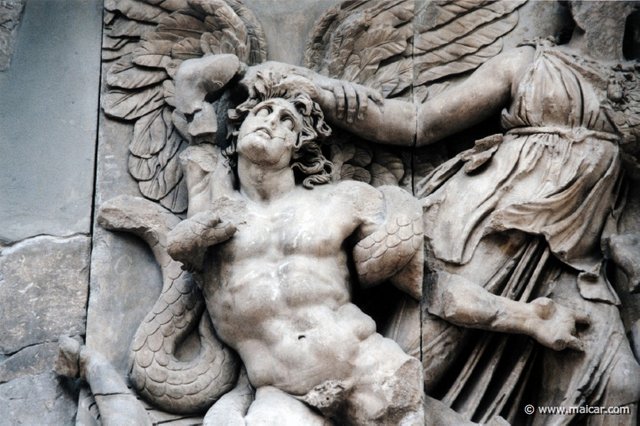
Giant Alcyoneus defeated by Athena (Pergamon frieze reconstruction at the Pergamon Museum in Berlin)
source
The problem is Uranus was well aware his children will try to overthrow him which is why he imprisoned all of them in Tartarus, deep within the Earth, causing a lot of pain to Gaia, the embodiment of our planet. Gaia forged a sickle so her children could free themselves and also castrate their father with it. In order to do that, the Titans led by Cronus enlisted the help of their less famous brothers the Cyclops, legendary figures of great strengths whose name comes from the fact they only had one round eye in the middle of their foreheads. At the same time, the Titans called upon their brothers, the Hecatoncheires, three beings of enormous size, who had 50 heads and one-hundred arms each. In Roman mythology, they go by the name of Centimanes, which means one hundred arms.
With such an impressive army, Cronus easily achieves his mission, he castrates his father and throws his genitals into the sea. Legend has some of Uranus’ blood fell upon Gaia, the earth, who subsequently gave birth to the Erinyes and the Gigantes.
The Erinyes are also known as the Furies or the ‘infernal goddesses’, as they are deities of vengeance and punishers of various sins.
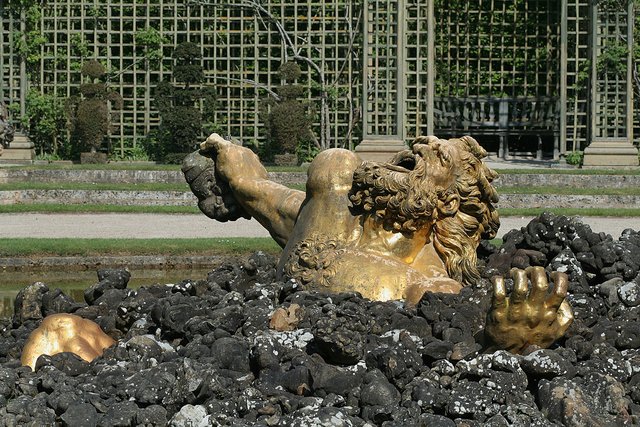
Giant Enceladus, opponent of Athena in the Gigantocmachy (bronze statue in the Versailles Gardens, Paris)
source
More relevant to our topic are the Giants, whose representation varies from one source to another. Not all ancient authors mention their size as being extraordinary, focusing instead on their huge strength and extreme violence. Hesiod, for instance describes the Giants’ as ‘strong’ and ‘great’, but it is unclear whether this refers to their size. In later writings, the Giants are increasingly represented as very big and quite mean. Some authors go as far as saying the Giants had snakes or scales on their feet. This subtle change in their description might have something to do with the fact that the Giants are guilty of the ultimate sin, battling the gods in what is generically known as The Gigantomachy. Seventh-century BC poet Alcman mentions the Giants as the embodiment of ‘hybris’, adding that "they suffered unforgettable punishments for the evil they did", that is challenging the Gods of Zeus generation on Mount Olympus. As we’ve already seen, like other mythologies, the Greek one is based upon one generation deposing another, with Cronus rising against Uranus only to be later vanquished by Zeus and his brothers and sisters. These violent acts are not perceived as particularly sinful, but when the Giants rise against Zeus that is considered a deed worthy of the worst punishment. It might look like double-standards being applied here and the answer is simple. Zeus won against the Giants and as we all know history is written by the winners.
The Gigantomachy is the most important divine struggle in Greek mythology, which explains why it is so amply depicted in Greek art. According to legend, the Giants could not be defeated by divine hands, which is why the gods of Olympus got themselves a tremendous ally, Greek hero Heracles, he of the twelve labors and son of Zeus and Alcmene.
Porphyrion and Alcyoneus, the greatest among the Giants, led the battle against the Gods. Porphyrion was made by Zeus to fall in love with Hera, whom he tries to rape, but is slain by one of Heracles’ poisoned arrows. Gaia sought to protect her offspring from destruction and set out to gather medicinal herbs to protect the Giants from harm. However, Zeus forbade the sun and the moon to shine, using the darkness as cover to steal the magic herbs himself.
If we look back at the Norse mythology, there the final battle, the Ragnarok, also pits the evil giants against the gods led by Odin. In both Greek and Norse story, the gods win.
Scenes of the epic battle can be found on numerous pots and vases of Ancient Greece, as well as many sculptures and friezes.
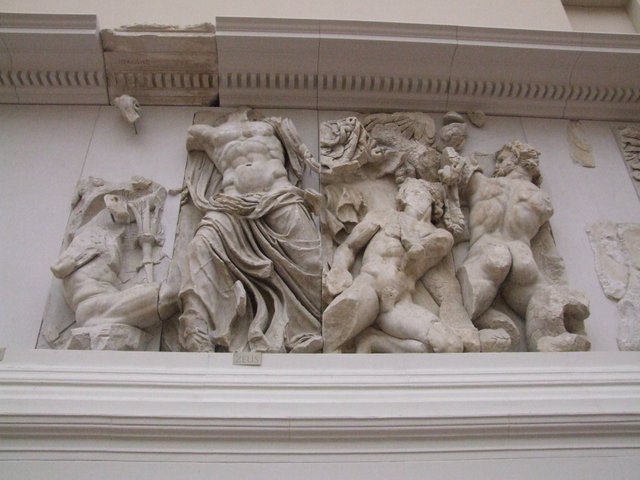
Reconstruction of the Gigantomachy frieze on the Altar of Pergamon (housed by the Pergamon Museum in Berlin.
source
Latin literature is full of references to the Gigantomachy, which Cicero sees as an allegory for the ‘fight against nature’. Virgil depicts the Giants as enemies of order and civilization.
Ancient Greek philosopher Epicurus comes with a different view and praises the storming of the heavens, with the Giants portrayed as heroic rebels against the tyranny of the Olympian gods. However, his is a singular voice. Such views are not usually encouraged as no regime in living memory ever liked change. Challenging the established order is always a terrible sin.
Greek mythology has many other giants. One of the best known is Atlas, son of titan Iapetus, was condemned to hold the sky upon his shoulders. According to Hesiod’s ‘Theogony’, Atlas can be found at the end of the Earth, in the extreme West. Later on, he was identified with the Atlas mountain rage in Northern Africa. At the same time, some texts credit him with the invention of astronomy.
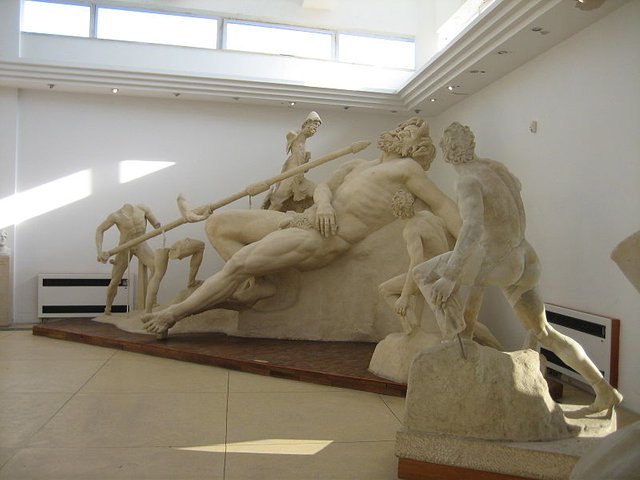
Blinding of Polyphemus, statue found at the villa of Emperor Tiberius at Sperlonga
source
Another well-known giant is the cyclop Polyphemus whom the hero Odysseus meets on his epic journey back from Troy. Polyphemus breaks the sacred laws of hospitality and instead of welcoming Odysseus and his crew eats two of the men and locks the others in his cave. This story is particularly important as the man-eating giant is a recurrent figure in folklore. For instance, English lore has the the story of ‘Jack, the Giant killer’ which tells the adventure of a young man from the Arthurian age going about slaying enormous creatures, described as evil and stupid.
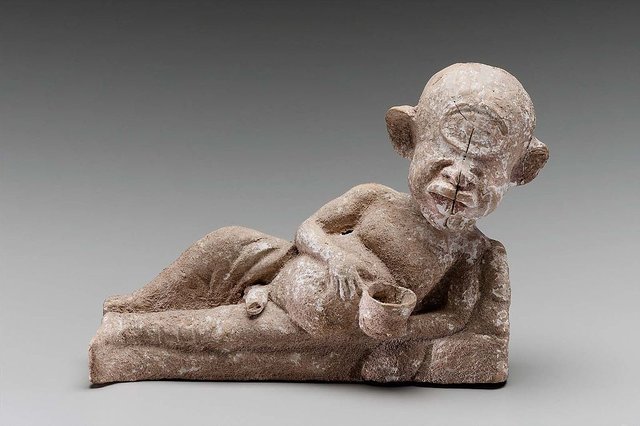
Ancient statue of Polyphemus drinking from a cup
source
So far in our analysis we have established there is a common thread in various mythologies speaking of the giants that rose against the gods and were duly punished for such act, which begs the question: was there ever another race on Earth, greater in size and more powerful than we, that the Gods destroyed? Interesting to note that at no time are these giants presented as being the ancestors of humankind. One way or the other, humans are described as being created by the Gods at a later date. Makes one wonder if all the Giants folklore is nothing but a cautionary tale for us humans, telling us not to rise against the skies if we do not want to share the giants’ fate?
Post authored by @ladyrebecca.
References: 1, 2.
Click on the coin to join our Discord Chat

Witness proposal is here:
Go To Steem Witness Page
In the bottom of the page type: adsactly-witness and press vote.

Use small letters and no "@" sign. Or, click here to vote directly!
Thank you!
I wonder how many schools in my country are teaching these kinds of topics. I asume it is being taught in most schools around the world as part of classical literature or folklore.
One of the things I find more fascinating about Greek mythology (I say greek because it is the most widely known, but similar stories can be found in most mythologies) is how easily it can be associated to human psychology and the different developmental stages.
All the dramas and intrigues we all go through have been somehow illustrated in some myth.
Regarding how we interpret these creatures, I agree with you in your assessment
We hear the word giant associated moderly to great people, of great intellect or ingenuity who have raised above the crowd and even though they may inspire admiration they are often the object of intrigues and attacks, precisely because their achievements tend to question or challenge the status quo or some dogma that dominates a given society at a given time.
I also think that giants, like many other supernatural or fantastic creatures present in oral traditions and in some religious texts are nothing but the result of our ancestors' imagination and inability to put in words something that in their time they could not quite grasp.
I try to imagine what it would have meant for people averaging 5 feet high to be in the presence of a 7 footer. Even today, with so many super athletes that tall, we can't but feel mesmerized in their presence. It was understandable for our ancestor to exagerate the feats of people that big or strong.
In your previous post I mentioned a legend in my country of how the great trees and mountains of the Gran Sabana were in principle giants that dared to face God. It seems that the diosses do not accept that they are bigger than them and with more power. In short, he also remembered the famous but enigmatic Colossus of Rhodes. I remember seeing some movies and having shuddered with this sculpture, imagining that someone could have this size. At present, there are many sculptures of gods or divinities that have great heights, perhaps in the representation of that greatness that all religions want to transmit, the power, the ominicience to be everywhere and above all. Great series, @ladyrebecca.
Thanks for the share of this history. Most African schools never teach it.
Posted using Partiko Android
The theme of the giants has a great attraction, as was said in part 1 of your work, @ladyrebecca. And in Greek mythology it seems to reach one of its most relevant milestones.
On the genealogy of gods and other mythical beings there are differences between scholars. For example, Karl Kerenyi, one of the most followed authorities, does not include the Titans among the Greek gods; he considers them prior to the divine stage, which would begin with the Olympic gods. And he initially associates hybris with them.
The review you make of the Greek giants is very complete. And the triumph of the gods over them would be the confirmation of the imposition of order over chaos.
Thank you for your illustrative post, @ladyrebecca.
Back in school, I love when we could learn about mythology. And after at University I try to know most of them, like: Arabic, Celtic or Persian. And if we think about all of this there are all connected, you can always compare one to the other and find similarities or plot which are intertwined.
Great post.
Posted using Partiko iOS